State of the economy: September 2020
This report summarises recent developments in the global, UK and Scottish economies and provides an analysis of the performance of, and outlook for, the Scottish economy.
Scottish Economy Update
Introduction
The coronavirus pandemic has resulted in an unprecedented global economic shock in 2020 resulting from the domestic and international restrictions on social and economic activity that have been required to slow the spread of the virus.
The Scottish economy has been no exception, with lockdown restrictions in the UK starting at the end of March and gradually easing from June onwards, with the economy supported by significant fiscal and monetary stimulus.
The latest economic data and surveys show the impact on Scotland's economy in the first half of 2020, during the lockdown period and are also starting to capture changes in activity as national restrictions have eased. These restrictions have driven the impacts we have seen on output and the labour market, and as restrictions continue to be required, they will continue to affect output and jobs.
During lockdown, it is estimated that only around 80% of businesses with a presence in Scotland were currently trading. As lockdown restrictions have eased this proportion has gradually risen to around 95% in August reflecting that the economy has largely reopened.[1]
However, this has varied by industry sector with lower proportions trading in the Arts, Entertainment & Recreation sector (69.4%) and Accommodation & Food Services (84.8%), reflecting the ongoing restrictions and weak demand facing those sectors.
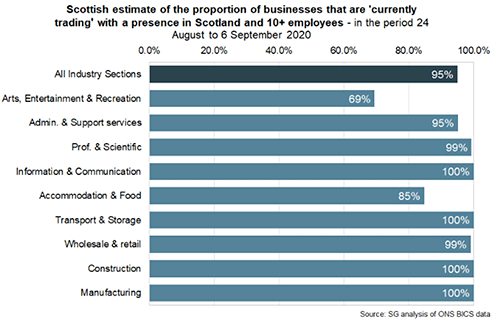
Furthermore, while businesses have gradually resumed trading, many are operating at below capacity. This is partially reflected in the proportion of businesses workforce that have been furloughed in recent months. The Coronavirus Job Retention Scheme has been a fundamental support mechanism for businesses and the labour market this year, supporting the retention of jobs and incomes across the economy. The new Job Support Scheme is less generous than the original furlough scheme and unemployment is still likely to continue to rise in the coming months.
In June, around 32% of Scotland's workforce was furloughed, which has gradually fallen to around 15% at the end of August, equivalent to around 217,000 jobs, with 67.2% of businesses with a presence in Scotland reporting having staff on furlough leave.
This emphasises the reopening of the economy, but also the continued widespread use of the scheme in August and signals that many business are potentially operating at below capacity due to ongoing restrictions and subdued demand. Similar to the trading status of businesses, the sectors with the highest shares of the workforce on furlough leave are in the Arts, Entertainment and Recreation Sector (57%) and Accommodation and Food sector (34%) reflecting the higher share of businesses in those sectors that remain temporarily closed or are operating below full capacity.
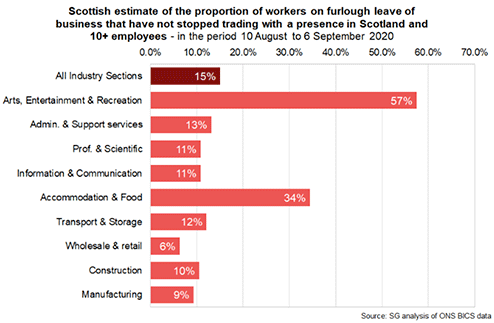
Output
GDP
In the first half of 2020, Scotland's economic output was initially impacted by the spread of coronavirus and implementation of restrictions internationally prior to the introduction of lockdown measures across the UK at the end of March.
Scotland's GDP fell 2.5% in the first quarter of the year before falling 19.4% in the second quarter, resulting in a total fall in output of 21.4% over the first half of the year.[2] This is broadly in line with the UK economy as a whole which shrank 22.1% over the same period.
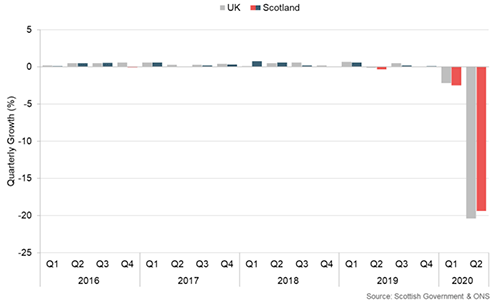
The scale of these contractions have been unprecedented. For example, while very different in nature, Scotland's GDP fell around 4% over six quarters during the global financial crisis. Furthermore, unprecedented falls in output over the first half of the year have been seen internationally also. In the Eurozone, GDP fell 15.1%, while in the US, GDP fell 10.1%.
In Scotland, the fall in output has been broad-based across sectors with services sector output falling 18.7% in the second quarter, while production sector output has fallen 15.7% and construction sector output by 41.5%.
The impact on sector GDP has very much been driven by the extent that restrictions have required business sectors to close, the ability for jobs to be continued from home and the extent to which demand has enabled businesses to continue trading (including at reduced capacity).
This variation has been particularly evident in the services sector in which Accommodation and Food Services output fell 76.7%, Transport and Storage fell 24.9%, while sectors with more flexibility to work from home and continue working, such as Financial and Insurance Activities, fell 3.4% and Public Administration and Defence growth was flat (0.0%).
In the Production sector, Manufacturing output fell 15.5% over the quarter, while Mining and Quarrying industries fell 28.9%, with output across industries most impacted by the capacity at which business operations have been able to operate and the extent to which supply chains have remained open.
Monthly GDP data provides further insight into the pattern of output growth over the lockdown period and as the restrictions have eased.[3]
Following the sharp fall in output over March and April (-4.9% and -20.1% respectively), Scotland's economy returned to positive growth in May and June, growing 10% over the two months. Growth was relatively broad based across the sectors, however was stronger in the production and construction sectors than in the services sector, reflecting the slower pace that restrictions have needed to ease in consumer facing parts of the services sector.
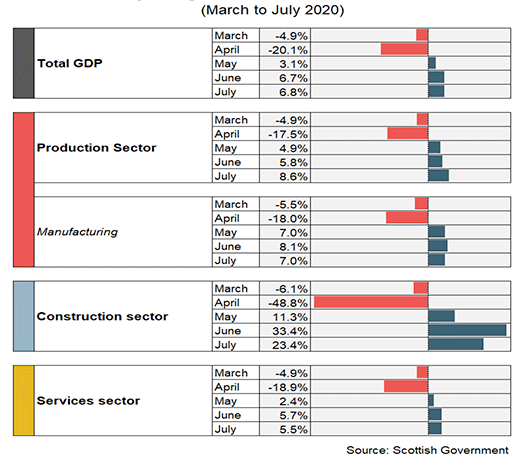
The latest monthly data for July shows the Scottish economy grew a further 6.8% over the month, with output continuing to recover across almost all sectors. Between May and July, the Scottish economy has recovered just over half the level of output that it lost over March and April. However the level of output remains 10.7% below its level in February prior to lockdown, on which the Production sector is 5.4% below and the Construction and the Services sectors are both 11.9% below.
Medium Term Outlook: Updated Scenario Analysis
The fall in economic output in Scotland this year has been smaller than initially expected in the "reasonable worst case scenario" produced in April. In part this is because some sectors of the economy proved to be more resilient and able to continue production to a greater extent than initially anticipated. Furthermore, our original estimate of a fall in GDP of around 30% in Q2 2020 was based on an assumption of a full 3 month lockdown, whereas the lifting of lockdown restrictions and reopening of parts of the economy began in May and June.
We have updated our scenario analysis with several key developments:
- We have moved to presenting a single central scenario accompanied by a "fan chart". This is similar to the approach of the Bank of England and reflects both heightened levels of uncertainty and incorporates an assessment of risk to the economy.
- We reflect the latest outturn economic data on the speed, shape, and nature of the economic recovery so far.
- We've incorporated updated fiscal policies, both domestically and internationally, including the Chancellor's announcement last week on further support for the labour market over the winter.
Updated scenario analysis
Our updated scenario analysis reflects these latest developments and the chart below shows Scottish GDP over the scenario horizon until Q1 2025, including a fan chart to represent the uncertainty and risks over the medium term.
Overall, we still expect the Scottish economy to be below pre-crisis levels by the end of 2020. Our central estimate is that, annually, GDP across 2020 as a whole could be 9.8% lower than 2019.
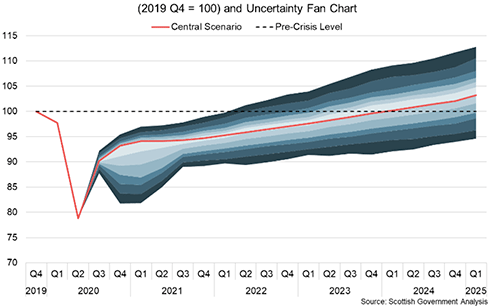
In the short term, there is a growing risk that economic growth could deteriorate for a number of potential reasons: (i) the need to introduce further local or national restrictions in order to protect public health; (ii) if consumers become more risk averse and cut back on spending; and (iii) a reduction in the level of support schemes. These are reflected in the scenario analysis fan chart and present asymmetric downside risks in late 2020 / early 2021.
Our medium-term outlook in the central scenario expects economic activity to return to pre-crisis levels by the end of 2023.
Over the period to 2025, we still expect a degree of scarring on the Scottish economy. By Q1 2025 our current expectation is that economic activity will be around 3% below pre-crisis trend. This is broadly in line with judgements from other economic forecasters, with the Office for Budget Responsibility[4] also indicating 3%, the Scottish Fiscal Commission[5] suggesting 4% and the Bank of England[6] citing 1.5%.
We have not changed our assumptions regarding the end of the EU transition period, and continue to assume an orderly transition to a trade deal that is agreed with the EU. Were this not to materialise this would act as an additional downside risk to the outlook.
Labour market
Last week the Chancellor announced a new Job Support Scheme (JSS) that will come into effect on the 1st of November as the original furlough scheme ends, and run until the end of April. This new scheme is a less generous wage subsidy scheme with employers having to pay a higher contribution, a minimum of 55% of an employee's usual salary, compared to 20% in October. The scheme is more complex than the JRS, and as a result the incentives for employers to use the scheme may be weaker, and some employers may prefer to cut staff hours, or let some staff go whilst keeping others in full-time employment.
In previous analysis we estimated that unemployment in Q2 2020 could be up to 10% had the furlough scheme not been put in place, compared to the current rate of 4.5% with the scheme.[7] Ahead of the Chancellor's announcement, we also published analysis showing that extending the Job Retention Scheme could suppress unemployment to around 7% in 2020 Q4.
Our latest central scenario for the labour market is represented below and our central scenario now has unemployment peaking at 8.2% in 2020 Q4. This reflects the assumption that the JSS will not be as effective at suppressing unemployment as the furlough scheme.
However, the outlook remains uncertain and the risk of a reversal in the economic recovery and the effectiveness of the JSS remain key uncertainties for the labour market which are reflected in our relatively wide fan chart in the short-term.
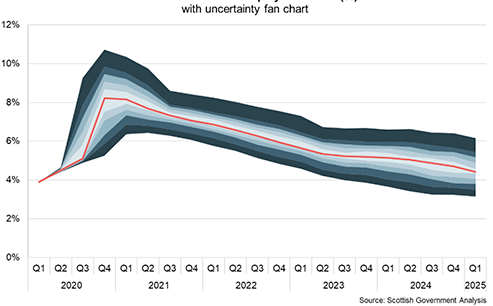
Over the medium-term our central scenario finds that the unemployment rate could remain elevated for several years and only start to reach pre-pandemic levels towards the end of the scenario horizon.
Trade
On the back of significant global trade headwinds and heightened Brexit uncertainty in 2019, businesses faced further trade disruption in the first half of 2020 due to the restrictions across countries and the impact on international supply chains.
In the second quarter of 2020 the value of Scotland's international goods exports[8] was £5.7 billion, a decrease of 31.1% compared to the second quarter of 2019. In terms of export destination, Scotland's goods exports to the EU fell by 19.8% to £3.1 billion and goods exports to non-EU countries fell by 41.1% to £2.6 billion.
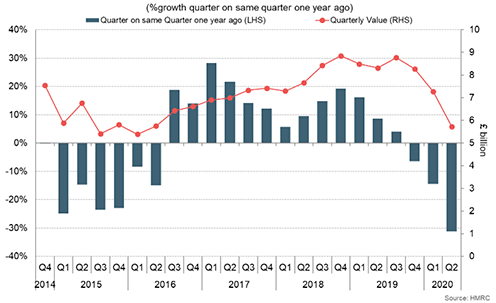
The decrease in exports was driven by a fall in oil and gas exports ('Mineral Fuels') which were down 52.4% compared to Q2 2019 and a fall in the exports of 'Beverages' (down 39.9% over the year).
ONS survey data suggests subdued trade activity has continued into the third quarter with 36% of Scottish trading exporters reporting that they were exporting less than normal in August/September alongside 31% of Scottish importers.[9]
At a UK level the Purchasing Managers Index[10] has also signalled that weak international demand and restrictions continue to weigh on export orders in August. Service sector exports continued to fall over the month, albeit to a lesser extent than in the second quarter, while manufacturing orders have marginally returned to growth for the first time in ten months. This emphasises both the current challenges that business supply chains are facing as countries across the world continue to adapt to the pandemic alongside existing headwinds to the international trade environment from 2019 and which will continue to impact over the course of this year and as the UK-EU exit transition period expires.
Business activity
The RBS Purchasing Managers Index (PMI)[11] has signalled that business activity in Scotland has been gradually stabilising since April as firms have adjusted to lockdown restrictions and have gradually resumed operations as restrictions have eased.
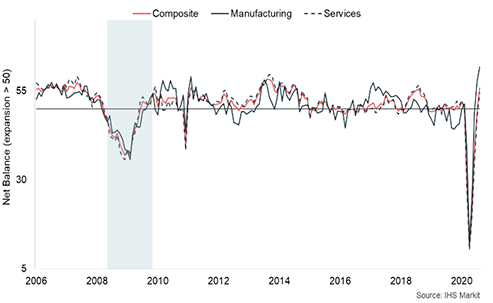
The latest PMI for August shows that business activity in Scotland returned to growth (55.8) for the first time since February, with growth across the manufacturing and services sectors. As with the GDP data, the pace of growth was slightly stronger in the manufacturing sector, likely reflecting the slower pace that restrictions have been eased from parts of the services sector.
The overall growth in business activity in August, was supported by a return to growth in new orders, suggesting that demand has picked-up over the month. However the business survey shows that firms continue to reduce staffing levels signalling that many are operating below capacity and the need to contain costs remain clear challenges for some businesses.
Turnover
The closure and scaling down of businesses during lockdown resulted in significant cashflow challenges for businesses, which remains a key risk as businesses have reopened and are adjusting to new operating conditions and subdued demand.
The Monthly Business Turnover Index[12] for July showed that most companies in Scotland continue to report that turnover has fallen compared to last year (28.5), though to a lesser extent than in the previous 3 months. The rise in the index since April indicates that there has been a gradual increase in business activity in recent months as lockdown restrictions have eased, however total output is still notably lower than last year (50 = same as last year).
Compared to last year, business turnover remains lower across both the manufacturing (35) and service (27) sectors, however both continued to strengthen over the month.
Within the Services sector, Accommodation and Food Services continued to be the industry with most businesses reporting a decrease in turnover over the year, followed by Culture and Recreation Services.
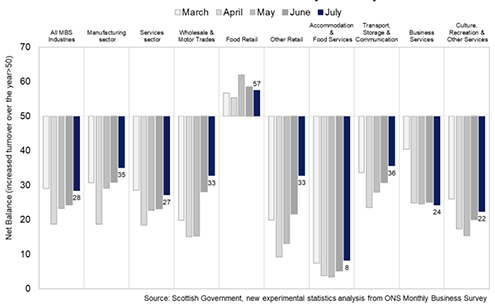
The index for most industry sectors continued to strengthen in July, particularly for non-food (other) retail, however Business Services fell slightly over the month and remains broadly unchanged since April.
The improvements in business turnover over the month across most sectors reflect the further reopening of the economy in July, however the extent to which business turnover remains below last year continues to emphasise the weak demand and operational challenges that businesses are facing.
Cashflow challenges, alongside the level of uncertainty, are likely to have significant implications for the scale and nature of business investment and the pace at which it recovers. In Q2 2020, the Scottish Business Monitor[13] reported that its new capital investment indicator was negative, with investment expectations strengthening but remaining negative overall. More recent data shows challenges still remain. ONS survey data for August/September shows that 30.5% of firms currently trading reported that capital expenditure is lower than normal and 12.6% that capital expenditure has stopped. At a UK level, 17.3% of firms have scaled down their business expansion plans while 19.7% of firms have postponed or cancelled them.[14]
Sectoral Variation in Impact and Potential Recovery
Whilst the economy has seen an unprecedented fall in activity in 2020, the impact has not been felt equally across all sectors. Some sectors have seen their output remain largely unchanged as a result of the pandemic as activity has been able to continue with staff working at home. Others, whilst having seen a fall-off in activity during lockdown, are now returning toward pre-crisis levels, having been able to first furlough their staff, and then bring them back without the need for recruitment or training. Within manufacturing, industries such as textiles and clothing, and chemicals, pharmaceuticals, and refined petroleum are already above their pre-pandemic levels.
However, a number of industries have been harder hit than others, particularly accommodation and food services and arts, culture, and recreation. These industries are particularly labour intensive, both employing around twice as many people as their economic size would suggest.
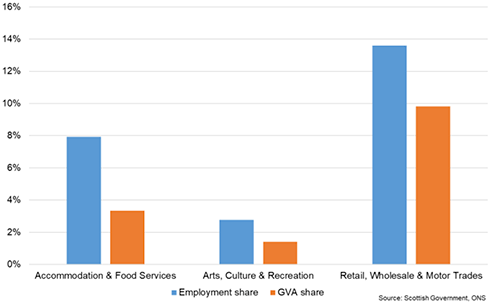
The recovery of some industries also masks variation within them. The retail and wholesale sector has largely recovered to pre-pandemic levels, but there are wide and potentially structural differences within the sector. Data for Great Britain shows that, overall, retail sales were above pre-pandemic levels in August, but within this online sales were 39% higher than February, whilst areas such as clothing stores remained 16% lower.
There had been a gradual shift toward online sales in recent years, but this may have been accelerated by the pandemic. If so, this is likely to have long term implications for employment patterns. Distance selling retail in general supports fewer direct jobs than physical retailing.
The challenging outlook for in-store retail and accommodation and food, which together account for around 1 in 5 jobs in Scotland, suggest that structural changes resulting from the pandemic could have large impacts on employment. Overall, the sectoral variation in terms of impact and recovery is striking.
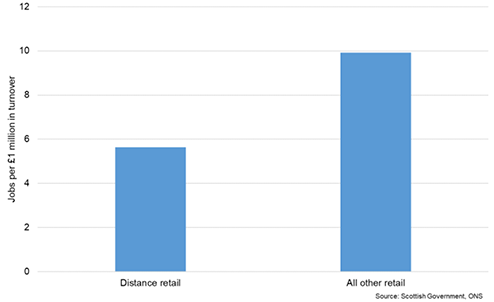
Labour Market
Unemployment rate and the Claimant Count
The impact of the pandemic on the labour market this year has varied across different types of employment, sectors and industries, reflecting the ability for jobs to be undertaken from home, whether businesses have closed or continued to operate. The Coronavirus Job Retention Scheme (CJRS) and the Self Employed Income Support Scheme (SEISS) have played a significant role in supporting the labour market since their introductions in March and April this year for workers in businesses that have needed to close or reduce capacity.
At the end of August around 15% of the workforce in Scotland was estimated to be on furlough leave (down from around 32% in June), while 126,000 self-employed individuals had made a claim to the second self-employment income support scheme. Both have helped retain employment and incomes for many people that may otherwise have been made unemployed by the requirement to close business and the collapse in demand.
Latest data for May to July show that Scotland's labour market has only slightly softened from last year, however this has been very much limited by the support schemes in place and headline figures are expected to continue to worsen in the coming months.
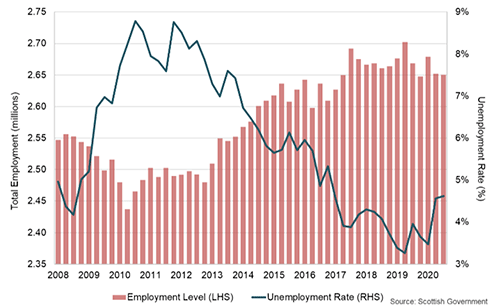
Scotland's unemployment rate in May to July was 4.6%, up 0.5 percentage points since the first quarter of the year and 0.7 percentage points compared to the same point last year. Alongside this, Scotland's employment rate was 74.3% (74.7% in January to March) and the inactivity rate was 22.0% (22.1% in January to March).[15]
Although these rates compare well against historical trends they only present a partial picture of the labour market and the impact of the coronavirus due to jobs on furlough being included in the employment level.
Scotland's Claimant Count (the number of claimants of Job Seekers Allowance and claimants of Universal Credit who were claiming principally for the reason of being unemployed) increased by 6.8% over the year to March 2020 (prior to the lockdown), however has increased by 103% between March and August following the introduction of lockdown restrictions. The number of claimants has increased to 225,800 in August (it was 111,400 in March), with the vast majority of the increase occurring in April/May and reflecting that the number of people that are unemployed or employed with low income and/or low hours has increased significantly.
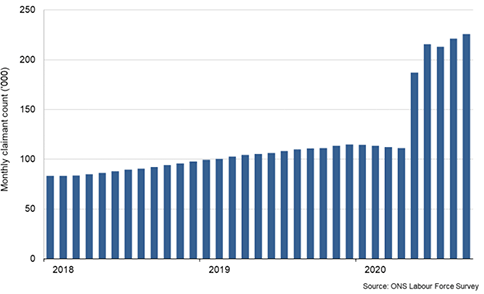
How does the UK's fiscal response to COVID-19 compare internationally?
Fiscal policy has played a central role in mitigating the immediate economic disruption from COVID-19 by supporting businesses and households as Governments adopted public health measures to contain the spread of the virus. As national lockdowns have been eased, some countries have already announced fresh rounds of fiscal stimulus to aid the economic recovery and support jobs.
According to the Office for Budget Responsibility (OBR), the UK Government's fiscal interventions were worth £192.3 billion, or around 9% of GDP as of July 14. The UK Government also committed to provide up to £330 billion (15% of GDP) of state-backed loan guarantees, although this has no impact on the public finances unless banks call upon these guarantees. On September 24, the Chancellor announced a winter economy plan, including a new Job Support Scheme to replace the current furlough scheme, as well as a further £24.3 billion of investment in public services. The costs of the new wage subsidy scheme will depend on take-up but could be around £300 million a month per million employees.
Including the Chancellor's latest announcements[16], the UK's fiscal response currently ranks 5th amongst other major advanced economies when considering both direct fiscal measures, such as tax cuts and spending increases, and liquidity measures, such as loan guarantees, as well as an indicative estimate of the EU's recovery fund.[17] Italy has provided the most generous fiscal response across the OECD to date, followed by Germany and Japan.
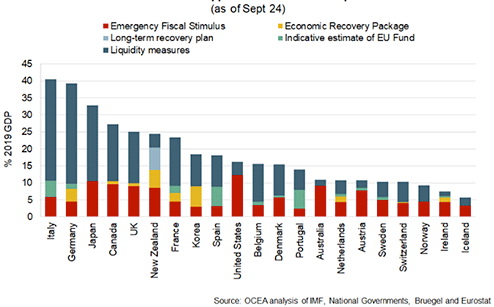
However, international comparisons need to be treated with caution as they reflect a number of factors, including the role and size of government, existing levels of debt and GDP, the stringency of the health measures and the depth of the economic crisis.[18]
The UK is one of at least nine advanced economies that have already announced fresh rounds of stimulus and measures to help kick-start the economic recovery. Although the UK saw the second largest fall in GDP across European countries, the scale of the UK's recovery package (around 1-2% of GDP including the winter economy plan) remains below that seen in other countries, including New Zealand (5% of GDP) as well as Germany and France (4% of GDP respectively). While Germany, Ireland and the UK have implemented timely and targeted VAT cuts to stimulate consumption in the short term, many of these recovery packages focus on delivering investment in green technologies, digitalisation and upskilling the workforce through apprenticeship schemes.
Synchronised fiscal action: The EU's recovery package
On July 21, European Union (EU) leaders agreed a €750 billion (5.4% of GDP) post-pandemic recovery package which supplements individual countries' fiscal responses to COVID-19. The deal marked a significant shift in EU policy as it introduced an element of fiscal risk-sharing, mutualisation of debt and limited central tax collection. However, it still needs to be ratified by Member States.
Around €390 billion of the €750 billion fund will be distributed as grants, which will not need to be paid back. Since these will not add to countries' debt levels, this will result in substantial fiscal transfers between member states. The remainder will be disbursed as loans.
For the first time, the EU will fund member states' expenditure by issuing joint debt. This is expected to predominantly benefit high-debt member states with limited fiscal headroom, such as Italy and Spain, as the EU is likely to pay much lower borrowing costs due to its current triple A rating. While this signals a first step towards greater solidarity and closer fiscal integration, the amount of debt is still moderate compared to the size of the EU economy and levels of national debt. The EU is also reportedly considering issuing part of its bonds as so called green bonds to finance Europe's transition to a green economy.
The grants will be distributed using a pre-defined allocation key which factors in population, GDP per capita, pre-COVID unemployment rates and, to a lesser extent, post-Covid economic performance. While the exact shares remain to be determined, high-debt countries hit hard by the pandemic, such as Italy and Spain, are expected to receive the largest grants in cash terms. However, relative to their GDP, Bulgaria, and Croatia would be the greatest beneficiaries (10% of GDP), while the highest-income countries, such as Germany and France, are expected to receive 2% of GDP or less.
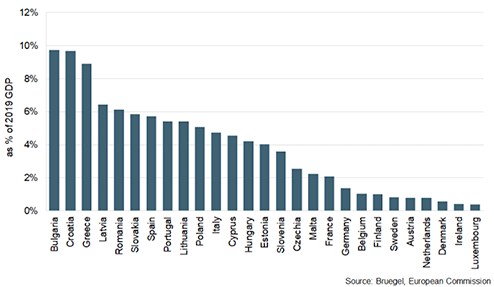
Demand and Supply for staff and Earnings
The full impacts of the pandemic on the labour market are continuing to emerge as the Job Retention Scheme winds down and will be replaced by the Job Support Scheme at the end of October.
The RBS Report on Jobs survey has signalled that labour market pressures are building in recent months with sharp falls in the demand for staff alongside a rise in staff availability (supply) indicating an increase in redundancies.
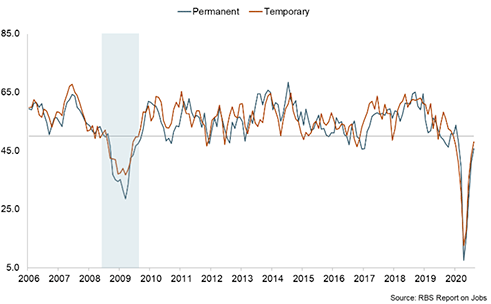
The latest data for August reported further falls in vacancies and placements of permanent and temporary staff, albeit to a lesser extent than in recent months, reflecting that businesses have been freezing or delaying hiring activity.
Alongside this, candidate availability remained elevated in August and rose sharply for permanent staff availability, suggesting a rise in redundancies, while pay pressures were evident with salaries appointed to permanent new staff continuing to fall, though at their slowest rate since March.
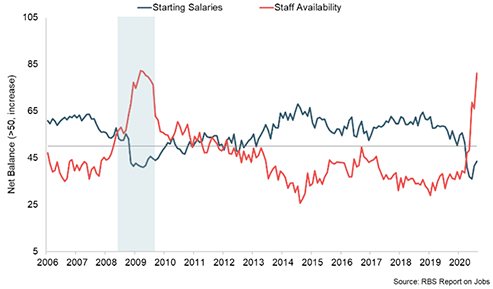
More broadly, HMRC PAYE Earnings data[19] captures the sharp slowdown in earnings growth that has emerged during the pandemic.
PAYE median monthly pay in Scotland in the three months to July was £1,859, a 1% increase from the same period in 2019 and a rebound back into positive growth following an annual decrease in the three months to June 2020. However the pace of growth remains notably slower than the c. 4% annual growth last year.
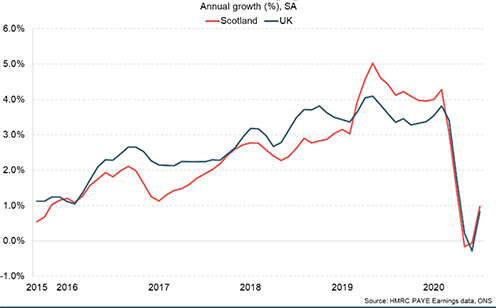
Consumption
Lockdown restrictions have had a significant impact on consumer sentiment and consumption activity which have shown some early signals of stabilising as restrictions have eased.
Consumer sentiment
UK consumer sentiment fell sharply during lockdown, reflecting weaker expectations about the performance of the economy and personal household finances.
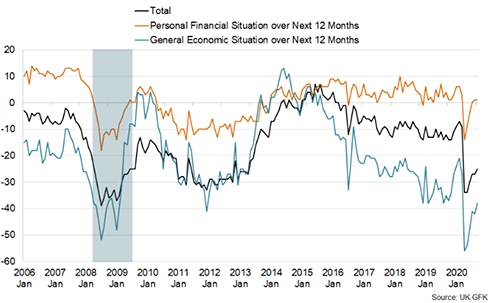
UK consumer sentiment has improved slightly from its low of -34 in April and May, and strengthened to -25 in September (up from -27 in July and August).[20]
In September, households' expectations for their household finances over the next 12 months remained marginally positive and unchanged from August while expectations for economic performance strengthened over the month. Attitudes towards making major purchases also strengthened, though all three indicators remain lower than their levels last year.
Retail sales
Scottish Retail Consortium data on retail sales for August[21] reported an annual decrease of 7.5% in total retail sales in Scotland, improving slightly from the 8.3% annual fall in July and further strengthening from the record fall in April (40.3%).
The decline in retail sales in August continued to be driven by a fall in non-food retail sales. Over the year to July, non-food retail sales fell by 15.1%, while food retail sales increased by 1.5%, with a slight easing in pace, possibly reflecting more people eating out.
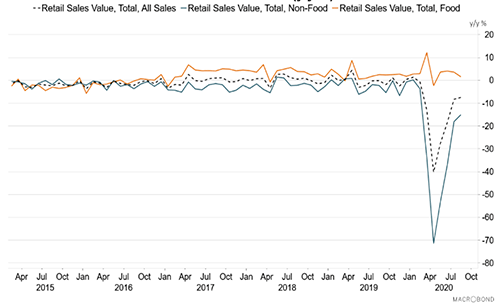
The combination of local restrictions, increased pressure on incomes and weaker sentiment are factors that likely drove the continued fall in retail sales in August compared to last year.
A Wellbeing Economy
Wellbeing and sustainable, inclusive growth are embedded at the centre of Scotland's National Performance Framework, the Scottish Government's approach to achieving social, environment and economic outcomes. For the economy, this means creating an economy that is environmentally sustainable, where businesses can thrive and innovate, and that supports all of our communities across Scotland to access opportunities that deliver local growth and wellbeing.
This approach to the economy has implications for how we define and measure 'economic success'. A key limitation with traditional measures, and in particular, GDP is that it is limited in what it tells us about how income or wealth is distributed across society, how 'good' that growth is and where it comes from, or whether it is sustainable for future generations. By looking beyond simple headline measures to consider outcomes across a range of broader performance criteria, we allow for a more rounded assessment of the quality of our economic performance and the distribution of economic opportunities across Scotland's places, regions and people.
A wellbeing economy promotes intergenerational wellbeing through maintaining the key stocks or capitals that are essential for driving future wellbeing and supporting social, economic and environmental considerations. The four capitals are the assets that generate wellbeing for current and future generations. These include:
1. Human capital. This includes the skills, competencies and mental and physical health status of individuals;
2. Natural capital. This includes critical aspects of the natural environment: assets and ecosystems.
3. Social capital. This includes civic engagement, social network support, personal relationships and trust, and co-operative norms.
4. Economic capital. This includes productive capital (buildings, transport infrastructure and knowledge assets such as Research and Development) and financial capital.
There is a growing body of international evidence from organisations such as the OECD which supports this approach and shows that reducing inequality and improving the wellbeing of citizens are important drivers of economic performance and resilience. The wellbeing economy agenda is not necessarily about zero or de-growth – it is a commitment to deliver an approach to the economy that maximises wellbeing and considers both the form and content of growth rather than growth per se. For example, reflecting the opportunities it provides to people and places, quality of life, environment and the support for all of our citizens.
The current economic crisis arising from the COVID-19 pandemic has highlighted the interconnectedness of social, economic and environmental outcomes, and the need to think about a holistic approach to the economic recovery and policy development going forward.
The negative impacts of the pandemic on the economy and on all impacts on wellbeing, have been widely documented. However, we have also seen positive opportunities emerging. For example, the speed and adoption of the use of technology has demonstrated how - in profoundly challenging times - use of technology can sustain employment, allowing work to continue and societal bonds to remain strong. We have seen a major shift in the use of the internet and digital capabilities to work, socialise, engage with public services and shop. On the environmental side, we have seen a fall in emissions and a behavioural change towards sustainable practices like active travel and working from home, although the extent to which these are locked in remains uncertain.
The long run impact of the crisis, on businesses, communities and households, will depend on duration and severity of the downturn, the speed of recovery and on the effectiveness of the response. Structural issues and changes are emerging that will determine the post-COVID-19 economy and recovery. For example, private debt overhang may constrain future capacity of businesses to invest. Dislocation of international supply chains has uncovered vulnerabilities in trading and business models and may lead to a search for more resilient alternatives, for example through increased localisation and diversification.
The pandemic has also led to a shock to current wellbeing and future capacity, but, as we emerge from the crisis, it is also an opportunity to renew our economy, build our resilience and future prosperity, and align recovery with our ambition for a wellbeing economy.
Delivering a wellbeing economy has been a central priority in recent years and Scotland is a founding member of the Wellbeing Economy Governments (WEGo) initiative, where member countries are working together to understand the key priorities for a wellbeing economy. Our membership of this group enables us to engage, learn and collaborate with other countries and utilise the advice of experts as we set our path to recovery and renewal.
Economic outlook
The Scottish economy has seen a record fall in output during the first half of 2020 during the national lockdown and, supported by unprecedented levels of fiscal and monetary stimulus over this period, we have seen the economy stabilise and start to recover as restrictions have eased.
However, the ongoing need to manage the spread of coronavirus and what that might mean for economic and social activity remains a central theme of uncertainty and risk to the economic outlook, alongside the changing scale and nature of fiscal support, and the pace at which businesses and households (domestically and internationally) can return to pre-pandemic levels of economic activity.
At a global level, the OECD and IMF project GDP to contract by 4.5% and 4.9% respectively in 2020 with significant variation across advanced and emerging market and developing economies. At a UK level the Bank of England project UK GDP could fall by 9.5% this year, similar to the latest average of new independent forecasts published by HM Treasury projecting a fall of 10% in 2020.[22]

In Scotland, the short term data and business survey information for quarter 3 2020 is looking more positive than in recent months as economic output and activity has started to stabilise and recover following the easing of lockdown measures. Our scenario analysis presented in this edition projects Scotland's GDP to strengthen over the second half of the year and contract by 9.8% over 2020, with economic activity expected to return to pre-crisis levels by the end of 2023.
However there are significant down side risks to this projection, particularly arising from the potential for further increases in the coronavirus infection rate and the need to reintroduce restrictions on economic and social activity.
Trading conditions remain challenging for businesses, with many operating below capacity and adapting to operate in a Covid safe manner, amid subdued demand and tight cashflow constraints.
Furthermore, the impacts on Scotland's labour market are continuing to emerge. Our central scenario shows that unemployment could peak at 8.2% at the end of this year, however the outlook remains uncertain and the risk of a reversal in the economic recovery and the effectiveness of the Job Support Scheme remain key uncertainties for the labour market.
Brexit and the prospect of completing the EU-UK Brexit transition phase at the end of the year without a deal, places further downside risks on the outlook for businesses and could further test the viability of some firms that are already facing a gradual recovery from the pandemic.
Contact
Email: OCEABusiness@gov.scot
There is a problem
Thanks for your feedback